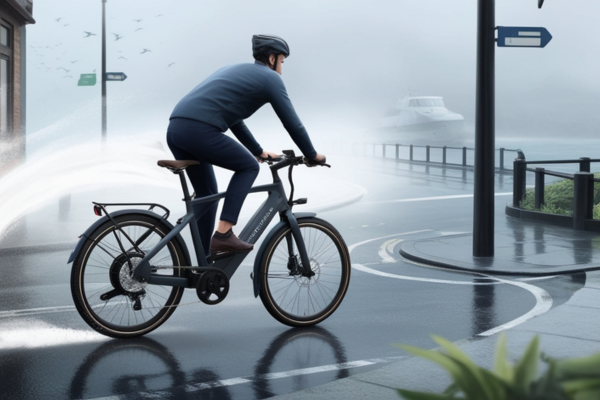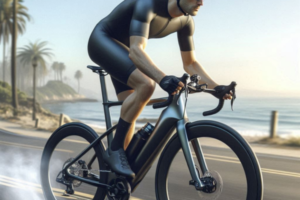🌬️ Understanding Wind Resistance in Humid Environments
Wind resistance, or aerodynamic drag, is one of the primary factors that limit the speed and efficiency of electric bicycles. While many riders associate drag with headwinds or high-speed travel, humidity plays a subtle but critical role in how wind resistance is experienced. In coastal or tropical environments, the increased moisture in the air influences both rider comfort and the mechanical response of the bicycle.
Humidity alters the composition of the air. Although moist air is less dense than dry air due to the lighter mass of water vapor molecules, the real-world riding experience tells a different story. In humid climates, other challenges emerge — from sweat-saturated clothing to slippery road conditions and component degradation — all of which interact with wind resistance in unexpected ways.
🚴♂️ Why Wind Feels Stronger in Humid Areas
Riders often report that winds feel more intense and riding feels heavier in humid areas. One reason is that high humidity affects the body’s ability to cool itself through sweat evaporation. When the body overheats, posture changes, reactions slow down, and fatigue increases — all of which result in a riding form that is less aerodynamic and more exposed to wind drag.
In addition, riders tend to wear looser, more breathable clothing in humid environments. Unfortunately, this type of apparel is prone to flapping and billowing in the wind, significantly increasing the surface area that catches air. This effect may feel like increased wind resistance, even though the air itself is not denser.
🧱 Environmental Obstacles Unique to Humid Areas
Humidity also contributes to environmental changes that indirectly increase resistance:
- Water on road surfaces adds friction, increasing rolling resistance especially on wider or softer tires.
- Rust buildup on chains and components causes drag and can lead to inefficient power transfer from the motor.
- Overgrown vegetation along paths or trails in humid zones often results in tighter spaces, forcing riders to swerve or slow down when facing gusts of wind.
- Unpredictable gusts are more common in tropical climates, where the combination of heat and moisture often causes microbursts and swirling winds.
These combined effects reduce overall riding smoothness and can trick the rider into compensating with more motor power, draining the battery faster and reducing range — especially on long, exposed stretches of road.
📏 Misconceptions About Air Density and Drag
It’s technically true that humid air has lower density than dry air, which should result in reduced aerodynamic drag. However, this benefit is usually outweighed by the secondary effects of humidity: rider discomfort, gear interference, and mechanical inefficiencies. As a result, electric bicycle users in humid regions may feel more wind resistance, even if the scientific drag coefficient remains unchanged.
🧍♀️ Rider Posture and Clothing: Hidden Drag Factors
Aerodynamic drag isn’t just about the shape of the bicycle — the rider plays a huge role. In humid environments, heat stress often forces riders into less efficient postures. When the rider leans less forward to increase ventilation or sits upright to reduce discomfort, the frontal surface area exposed to wind increases. This simple shift in posture can raise drag significantly, especially when riding above 20 km/h.
In addition, clothing plays a silent but powerful role. Tight, aerodynamic gear is ideal for minimizing drag, but in high-humidity conditions, cyclists often opt for looser, breathable, and quick-drying apparel. Unfortunately, this kind of fabric tends to flap in the wind, acting like a parachute. The result is an increase in wind resistance that may not be felt immediately but accumulates over the duration of the ride, leading to greater motor usage and reduced battery range.
🪶 Weight and Material Absorption
In humid regions, not only do cyclists sweat more, but their gear and clothing tend to absorb and retain that moisture. A water-saturated backpack, wet gloves, or soaked padding can increase the total load the bike must carry. While the added weight may seem small, it becomes significant on longer rides or hilly terrain, where additional drag and gravitational resistance compound the effort required.
Moreover, e-bike accessories — such as panniers, seat covers, or handlebar bags — may expand or deform slightly when exposed to high humidity or direct mist, increasing their drag profile. Riders rarely consider these factors when attributing wind resistance, but they are key contributors to the sensation of “fighting the wind” on damp rides.
💡 Strategies to Reduce Aerodynamic Drag in Humid Areas
Fortunately, there are practical ways to reduce wind resistance while still maintaining comfort and safety in humid zones. Here are several tips:
- Choose fitted moisture-wicking gear: Look for fabrics that both breathe well and maintain shape when wet.
- Streamline your load: Use compact, aerodynamic bags and avoid hanging items from handlebars or racks.
- Maintain posture training: Practice aerodynamic positions in short intervals to balance airflow efficiency with comfort.
- Use smooth surfaces: Accessories with clean, tight-fitting covers create less turbulence than open mesh or bulky shapes.
🌫️ Managing Condensation and Visibility
Another side effect of humid wind is condensation, particularly in early mornings or after light rain. Visors, glasses, mirrors, and display screens can fog up, disrupting the rider’s ability to anticipate wind shifts or environmental cues. Loss of visibility can lead to posture changes, unsteady movement, or overcorrections that expose the rider further to aerodynamic drag.
To address this, riders should use anti-fog treatments on lenses and displays, opt for open-ventilation helmets, and avoid wearing items that trap warm air near the face. Small changes in visibility often lead to big changes in body position — and therefore, in wind resistance.
🌧️ Wind Turbulence and Weather Patterns in Coastal Zones
Humid coastal areas are known for their unpredictable weather. Sudden wind shifts, gusts from nearby bodies of water, and microbursts can create irregular turbulence, which impacts both balance and aerodynamics. Unlike dry climates, where winds are often consistent, humid zones introduce swirling air currents and crosswinds that demand more physical and mental attention from riders.
These changing patterns disrupt the natural flow of cycling and reduce the effectiveness of any streamlined riding position. A rider leaning forward into a tailwind might suddenly be hit by a side gust, forcing corrective action and momentarily breaking aerodynamic form. Over the course of a ride, these disruptions lead to cumulative energy waste and greater battery usage — especially on open roads and bridges.
🌿 Environmental Obstacles That Amplify Drag
Humidity promotes the rapid growth of vegetation, which in turn can lead to narrow or obstructed bike paths. Plants growing onto paths or branches weighed down by moisture create physical obstacles that alter a cyclist’s trajectory. Each swerve, slowdown, or repositioning caused by these elements adds to drag by disrupting flow and rhythm.
Additionally, many coastal cities feature older infrastructure with uneven surfaces and wind channels created by buildings and tunnels. In humid air, these tight spaces trap moisture and intensify wind resistance, especially at intersections or sharp corners where winds can be deflected back at the rider.
🔧 Equipment Degradation from Moisture Exposure
When riding regularly in humid areas, the wear on components like bearings, brakes, and cables is accelerated. Rust increases friction, and weakened parts may no longer allow for tight, efficient movement. The result is increased mechanical resistance, which can be confused with wind resistance because the bike responds more sluggishly to rider input.
To the rider, this may feel like stronger wind pushing against the bike, but it’s often the drag of degraded mechanics struggling to perform under load. This is especially common in riders who neglect regular maintenance or underestimate how quickly corrosion sets in under constant moisture exposure.
🧰 Preventive Maintenance to Minimize Drag
Keeping your e-bike in top condition is one of the most effective ways to manage perceived wind resistance in humid conditions. Here are key practices:
- Apply anti-corrosion treatments to your drivetrain, bolts, and exposed wiring every two weeks.
- Use ceramic lubricants that hold up better in damp conditions without thickening.
- Inspect and clean brake calipers and rotors weekly to ensure no buildup of salt or grime.
- Check tire pressure regularly, as low pressure increases surface contact and rolling resistance, amplifying drag.
Maintenance isn’t just about preserving your bike — it’s about preserving aerodynamic integrity. A well-tuned machine slices through the wind more efficiently, especially when battling the additional resistance brought on by humidity and wind interplay.
📐 Aerodynamic Accessories That Help in Humid Climates
Even in challenging environments, riders can equip their e-bikes with accessories that help reduce wind resistance. The key is to choose gear that is lightweight, resistant to water absorption, and designed to preserve streamlined flow. In humid areas, special attention should be paid to how accessories perform when exposed to moisture over time.
- Aerodynamic panniers: Opt for hard-shell or teardrop-shaped models that are water-resistant and minimize wind turbulence around the rear wheel.
- Low-profile fenders: Essential for wet roads but should be sleek and close-fitting to avoid unnecessary drag.
- Compact lighting systems: Lights and reflectors should sit flush with the frame to avoid disrupting airflow, especially during foggy or misty morning rides.
- Handlebar fairings or small wind deflectors: Though more common on motorcycles, minimalist versions exist for e-bikes and help reduce wind impact on hands and chest.
All accessories should be mounted securely to avoid vibration or movement during the ride. Even small rattles or wobbles increase wind disruption and may cause long-term discomfort, which indirectly affects posture and performance.
👁️ Visibility, Safety, and Wind Balance
While optimizing for aerodynamics, it’s important not to overlook visibility and control. Riders in humid zones frequently encounter mist, fog, and low light — conditions that call for increased visibility gear. However, not all reflective equipment is created equal. Wide vests or flapping reflective sashes can increase drag and make the rider more susceptible to wind imbalance.
The best strategy is to use integrated visibility solutions, such as reflective piping on close-fit clothing, compact helmet lights, or built-in frame LEDs. These provide the necessary safety without significantly increasing wind exposure.
💨 Battling Crosswinds in Coastal Cities
One of the most difficult forms of wind resistance to overcome is the crosswind. In coastal areas, sudden lateral gusts can push riders off course, especially when combined with uneven terrain or heavy traffic. While aerodynamically streamlined bikes offer less surface area to side winds, rider balance and reaction time are equally crucial.
To maintain control and reduce drag in these situations:
- Keep a light but firm grip on handlebars, allowing flexibility without stiffness.
- Avoid using large, soft-sided backpacks that act like sails when winds hit from the side.
- Ride slightly lower on the bars to reduce your exposed profile and better center your gravity.
- Practice handling drills in open areas to become more accustomed to reacting smoothly to wind shifts.
Experienced riders also learn to adjust their riding path slightly, leaning into crosswinds just enough to counter the force without compromising their trajectory. With practice, this becomes second nature — especially valuable in high-humidity regions where coastal winds are frequent and unpredictable.
🧠 Training the Mind and Body for Wind Awareness
Reducing the impact of wind resistance in humid areas isn’t only about equipment and posture. It also involves building awareness and adaptability through training. Cyclists who regularly ride in tropical or coastal environments benefit from understanding how to read the wind — not just react to it. Developing this intuition helps prevent energy waste and improves safety.
Training your body to maintain posture under pressure, and your mind to anticipate gusts or resistance changes, can make a noticeable difference in long rides. Simple strategies include:
- Riding familiar routes at different times of day to observe wind and moisture patterns.
- Using weather apps with wind direction and humidity overlays to prepare mentally before riding.
- Practicing interval training on windy days to build strength and balance in response to drag forces.
💼 Realistic Expectations and Energy Management
In humid environments, it’s important to adjust expectations. The same route may take longer or feel more exhausting in high humidity and wind. Rather than push harder, smart riders focus on managing energy — using pedal assist efficiently, planning rest stops, and avoiding the temptation to overpower natural resistance with brute force.
Most electric bicycle systems offer multiple assist levels. Riders should select lower settings on flat roads and reserve higher assist modes for hills or strong headwinds. This strategy not only extends battery life but also gives the motor and controller time to cool down, which is essential in hot and humid conditions where overheating is a risk.
📊 Monitor and Track Your Performance
Using ride-tracking apps or integrated e-bike metrics can help you spot patterns that influence performance. Some smart systems even log wind speed, humidity, and rider drag over time. By analyzing this data, you can adjust your gear, route, or riding posture to gradually reduce drag and improve efficiency — especially during commutes or long-distance travel.
Track changes in average speed, battery consumption, and distance per charge across different weather conditions. Over time, this information becomes an invaluable personal reference for making better decisions and achieving smoother, safer rides.
💬 Final Thoughts
Wind resistance is a challenge for all e-bike riders — but in humid areas, it takes on new dimensions. From the way your gear absorbs moisture to how your posture shifts under heat, every factor plays a role. Understanding these dynamics is the first step to overcoming them.
By combining smart gear choices, mindful riding, proactive maintenance, and awareness of your environment, you can reduce drag, extend range, and stay comfortable in even the stickiest conditions.
What’s your go-to solution for riding through humidity and wind? Share your insights and tips in the comments to help other riders navigate the breeze more efficiently.



